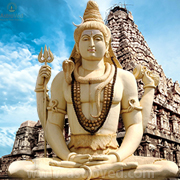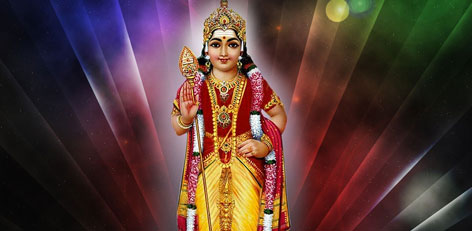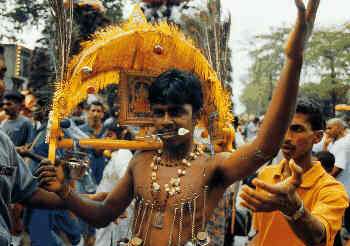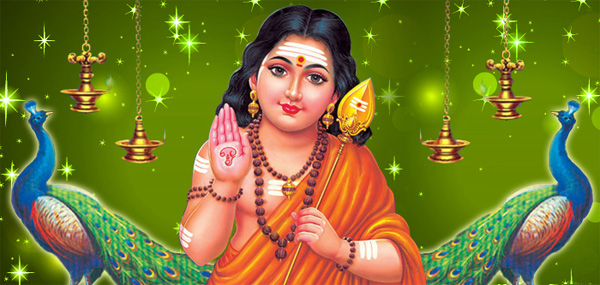Courtesy: Sri.S.Ramaswamy
Thai Pusam Festival
Namaste,
On February 3 (IST), the Moon will be aligned with the most spiritual star in our galaxy known as Pushya, located in the zodiac sign of Cancer. The Moon represents the mind principle and the Pushya star is associated with higher intelligence. For seekers of higher consciousness and enlightenment the most important day of the month is when the Moon aligns with the Pushya star. However, one particular Pushya star in a year is very important and it occurs in the month called Thai. In ancient and modern India, this day is referred to as "Thai Poosam". On this day, we can free our self from old thought patterns that are currently limiting us. Yogis and spiritual adepts know this Moon-Star combination creates a powerful opportunity for spiritual and personal evolution. On Thai Poosam, we can accomplish in one hour what we won't be able to accomplish in several years of meditation.

3 Mythical/Historical Events Connected with Thai Poosam:
- Lord Shiva came to the Earth plane to evolve the planet and liberate people. We can create an abundant amount of intelligence.
- Lord Muruga, the son of Shiva, received his spear (Vel) on this day. The Vel is simply not a weapon, it means a couple of things: super intelligence, also the psychic weapon that dissolves stubborn karma.
- Swami Ramalingam merged with the Jyoti Light of Lord Shiva. On the Pushya star and Full Moon day in 1874, He made his final merger with the light complete and physically disappeared from the Earth plane. No traces of his body were ever found.

Astrology behind Thai Poosam: Day of Light
This year's Thai Poosam is significant because astrologically, the Moon will be along with an Exalted Jupiter. This is a special alignment that will not be seen again for another 12 years. The presiding deity for the Pushya star is Lord Jupiter himself, who was born on a Pushya star. The Moon will be along with an exalted Jupiter and this creates an extra powerful and special Gaja Kesari Yoga. The Moon is an extremely nurturing planet and is very pleased when food is donated. Therefore, any food donated on a Full Moon day while the Moon is in its own sign of Cancer is considered very good. Worshiping Lord Muruga on this day will bring in wealth, prosperity and good health. In addition, Muruga will use planetary positions for this day to improve and protect the following areas of life:
- Relationship Problems: Mars and Venus both in 8th house from the Moon.
- Improve relationships at the workplace with better communication: Mercury and the Sun in the 7th house to the Moon.
- Career improvement: The planet Saturn in the 5th house to the Moon.
- Financial improvement: Jupiter along with the Moon and also Venus in the 8th house to the Moon. Venus in the 8th house is good for financial prosperity.
- For better living: Rahu is in the 3rd house to the Moon will give progress in all matters.
- To dissolve real estate karma: Real estate karma will be dissolved. Difficulties related to real estate will now be resolved. Muruga will bless you with an own house.
- Spiritual enlightenment: Ketu in the 9th house to the Moon supports higher levels of spirituality.

|
Thaipusam

| Thaipusam , Thaipoosam , தைப்பூசம் , 大寶森節 | |
|---|---|
 Murugan during Thaipusam. Murugan during Thaipusam. | |
| Observed by | Religiously by Tamil Hindus. |
| Type | Religious, India, Malaysia, Sri Lanka, Mauritius, Fiji , South Africa , Singapore, Indonesia, Guadalupe, Reunion, Thailand and Myanmar |
| Significance | The festival commemorates the occasion when Parvati gaveMurugan a Vel, so that he could vanquish the evil demonSoorapadman. |
| Date | decided by the Tamil calendar |
| 2014 date | Friday, 17 January 2014 |
| 2015 date | Tuesday, 3 February 2015 |
| 2016 date | Saturday, 23 January 2016 ** |
Thaipusam "Thaipoosam" (Tamil: தைப்பூசம், Taippūcam ?) is a Hindu festival celebrated mostly by the Tamil community on the full moon in the Tamil month of Thai (January/February). It is mainly observed in countries where there is a significant presence of Tamil community such as India, Sri Lanka, Malaysia,[1] Mauritius[2] Singapore,Guadalupe, Reunion, Indonesia, Thailand and Myanmar[3]
The word Thaipusam is a combination of the name of the month, Thai, and the name of a star, Pusam. This particular star is at its highest point during the festival. The festival commemorates the occasion when Parvati gave Murugan a Vel "spear" so he could vanquish the evil demon Soorapadman. There is a misconception among people that Thaipusam marks Murugan's birthday; however, it is believed that Vaikhasi Vishakam, which falls in the Vaikhasi month (May/June), is Murugan's birthday.,[4]
Contents
[hide]Origin[edit]
Skanda (or Murugan) was created during one of the battles between the Asuras (or to be more specific Soorapadman) and theDevas. At one point, the latter were defeated several times by the former. The Devas were unable to resist the onslaught of the Asura forces. In despair, they approached Shiva and entreated to give them an able leader under whose heroic leadership they might obtain victory over the Asuras. They surrendered themselves completely and prayed to Shiva. Shiva granted their request by creating the mighty warrior, Skanda, out of his own power or Achintya Shakti. He at once assumed leadership of the celestial forces, inspired them and defeated the Asura forces and to recognise that day the people created the festival, Thaipusam.
Skanda Puranam[edit]
According to Skanda Puranam, the legend of Murugan, and Thirupugal which are divine verses on Murugan, adhere to Shaivam principles.Murugan is the embodiment of Shiva's light and wisdom and devotees pray to him to overcome the obstacles they face, as He is the divine vanquisher of evil. The motive of Thaipusam festival is to pray to God to receive his grace so that bad traits are destroyed.[5]
Kaavadi[edit]
Kavadi cavadee Attam is a dance performed by the devotees during the ceremonial worship of Murugan, the Tamil God of War.[6] It is often performed during the festival of Thaipusam and emphasises debt bondage. The Kavadi itself is a physical burden through which the devotees implore for help from the God Murugan.[7]
Generally, Hindus take a vow to offer a kavadi to idol for the purpose of tiding over or averting a great calamity. For instance, if the devotee's son is laid up with a fatal disease, he would pray to Shanmuga to grant the boy a lease of life in return for which the devotee would take a vow to dedicate a kavadi to Him.
Preparations[edit]
On the day of the festival, devotees will shave their heads and undertake a pilgrimage along a set route while engaging in various acts of devotion, notably carrying various types of kavadi(burdens). At its simplest this may entail carrying a pot of milk, but mortification of the flesh by piercing the skin, tongue or cheeks with vel skewers is also common.Devotees prepare for the celebration by cleansing themselves through prayer and fasting approximately 48 days before Thaipusam. Kavadi-bearers have to perform elaborate ceremonies at the time of assuming the kavadi and at the time of offering it to Murugan. The kavadi-bearer observes celibacy and take only pure, Satvik food, once a day, while continuously thinking of God.
The simplest kavadi is a semicircular decorated canopy supported by a wooden rod that is carried on the shoulders, to the temple. In addition, some have a small spear through their tongue, or a spear through the cheeks. The spear pierced through his tongue or cheeks reminds him constantly of Lord Murugan. It also prevents him from speaking and gives great power of endurance.
Celebrations[edit]
In Vadalur (Cudalore district), Saint Vallalar (1823–1874)(Ramalinga Adigalar) established Sathya Gnana Sabai(Lotus Temple). He kept 7 Screens and Camphor lighted Jothi every thaipusam day at 6am, 10am, 1 pm, 7 pm, 10 pm, and the next day 5:30 in this temple. Every monthly Pusam day 7 pm half screen Jothi Darshan performing. This was established in the year 1872, which is the Arutperumjothi Darshan. It can be seen monthly once and yearly six times only, on the state Government Declare local Holiday for the cudalore district.In Palani, Tamil Nadu, India, Thousands of devotees flock to Palani and attend kavadi. According to palani.org, "The number of kavadis reaching Palani for Thai Pusam is about 10,000. For Pankuni Uttiram, 50,000 kavadis arrive. It is kavadi to your right, kavadi to your left, kavadi in front of you, kavadi behind you, kavadi above you and kavadi below you."[8]
In Haripad Subramayawsami Temple, Alapuzha, Kerala is famous for Kavadiyattom.Almost 5000 kavadis coming to the temple from many temples in the locality. garga
In Keezhattingal Subrahmanya swamy Temple, Attingal, Thiruvananthapuram, 10000 kavadis coming to the temple from many various temples in the localitty.
In Vaikom, Kerala, India, Thai Pusam festival is conducted with Kaavadis at Udayanapuram Subramanya temple. Devotees take panchamritha kaavadi, paal kaavadi, bhasma kaavadi, etc.
In Karamana, Thiruvananthapuram, Kerala, India, Thai Pusam festival is conducted at Satyavageeswara temple. The utsava moorthy is taken in procession on a vahanam (mount). There is nel(Paddy)parai alappu or Nel alavu, as a ritual performed for good luck and prosperity.
In Cheriyanad Subrahmanya Swami Temple, Chengannur, Alappuzha District, Kerala, India, Thai Pusam is celebrated with more than 500 Kavadis. The rituals are followed in strict manner.
In Nallur, Jaffna, Sri Lanka, Thai Pusam festival is conducted at Nallur Kandhasamy Temple. Many Tamil devotees irrespective of religion take part in celebrations. Even Tamils from Roman Catholic faith and Muslims take part in Thai Pusam celebrations and take Kavadis.
Outside Tamil Nadu[edit]
| Part of a series on |
| Hinduism |
|---|
 |
Schools[show] |
Practices[show] |
The largest Thaipusam celebrations take place in Mauritius, Malaysia and Singapore.[9] It is a public holiday in several states in Malaysia, including Kuala Lumpur, Putrajaya, Selangor, Penang, Perak, Kedah, Johor, Negeri Sembilan. Mauritius, Sri Lanka, Singapore and Reunion
Thaipusam in Malaysia[edit]
Batu Caves[edit]
In Malaysia, the temple at Batu Caves, near Kuala Lumpur, often attracts over one million devotees and tens of thousands of tourists.[10] The procession to the caves starts at the Sri Mahamariamman Temple, Kuala Lumpur in the heart of the city and proceeds for 15 kilometres to the caves, an 8-hour journey culminating in a flight of 272 steps to the top.Devotees carry containers containing milk as offering to Lord Murugan either by hand or in huge decorated carriers on their shoulders called 'kavadi'. The kavadi may be simple wooden arched semi-circular supports holding a carrier foisted with brass or clay pots of milk or huge, heavy ones which may rise up to two metres, built of bowed metal frames which hold long skewers, the sharpened end of which pierce the skin of the bearers torso. The kavadi is decorated with flowers and peacock feathers imported from India. Some kavadi may weigh as much as a hundred kilograms. After bathing in the nearby Sungei Batu (Rocky River), the devotees make their way to the Temple Cave and climb the flights of stairs to the temple in the cave. Devotees use the wider centre staircase while worshippers and onlookers throng up and down those balustrades on either side. When the kavadi bearer arrives at the foot of the 272-step stairway leading up to the Temple Cave, the devotee has to make the arduous climb. Priests attend to the kavadi bearers. Consecrated ash is sprinkled over the hooks and skewers piercing the devotees' flesh before they are removed. No blood is shed during the piercing and removal.
Penang[edit]

Thaipusam is celebrated at Tannirmalai Arulmigu Balathandayuthapani Temple in George Town. It is one of the main events in Penang. On the eve of Thaipusam, a silver chariot with the statue of Lord Muruga is led on a procession, accompanied by Chettiar kavadis or devotees, carrying peacock feathers. The procession usually starts at 6.00am departing from Kovil Veddu (Temple House) at Market Street and travelling through Chulia Street, Victoria Street, Prangin Road Ghaut, C.Y. Choy Road, Magazine Road(KOMTAR), Datuk Keramat Road, Irving Road, Jalan Utama and Waterfall Road on its route. It reaches the Nattukkottai Chettiar Temple at Waterfall Road at about midnight, culminating a 15-hour journey . On the eve day, coconuts are smashed on the roads before the chariot to symbolise the shattering of one's ego in the pursuit of self-realization. In addition, devotees also make offerings of fruits, flowers and incense to the Lord Muruga in the Silver Chariot.On Thaipusam Day, devotees undertake a pilgrimage from the Lorong Kulit temple to the Thannirmalai Arulmigu Balathandayuthapani Temple. It is located high on a hill. Carrying kavadis can be an act of penance or fulfilment of a vow done to develop spirituality. The kavadis can take the form of Paal Kudam (milk pots) as offerings to god or in the form of physical endurance by piercing the cheeks, tongue, or skin on the body with hooks and Vel skewers. The Thannirmalai Arulmigu Balathandayuthapani Temple can accommodate up to 800,000 devotees for the annual Thaipusam Festival. Devotees need to climb over 500 steps to reach the hilltop temple. This is more than the 272 steps at the famous Batu Caves (Kuala Lumpur). Upon reaching the temple, devotees will fulfill their vows, offer thanksgiving prayers and penance to Lord Muruga.On the next day, the silver chariot with Lord Muruga makes a return trip to Kovil Veedu at Market Street from the Nattukottai Chettiar Murugan Temple . The return trip from the Waterfall temple lasts from 6.00 pm until dawn the next day. It takes a different route back, passing through Waterfall Road, Gottlieb Road, Jalan Tunku Abdul Rahman, Cantonment Road, Macalister Road, Anson Road, Burmah Road, Transfer Road, Sri Bahari Road, Penang Road, Campbell Street, Buckingham Street, Jalan Mesjid Kapitan Keling, Chulia Street, Queen Street, China Street, Beach Street and Market Street. On this day, the same activities that were carried out on the eve of Thaipusam are carried out again along the route of the procession.During this three-day celebration, one can find over 100 beautifully decorated stalls erected along Western Road and Gottlieb Road. These stalls sell traditional Indian goods, souvenirs, decorative items and snacks and refreshments. Thunderous loud music, singing, dancing and the beating of drums can be seen and heard from afar throughout the festival. This is a festival of rich culture and deep tradition in Penang.
Thaipusam in Singapore[edit]

In Singapore, Hindu devotees start their procession at the Sri Srinivasa Perumal Temple in the early morning, carrying milk pots as offerings or attaching "kavadis" and spikes pierced on their body.[11] The procession travels for 4 kilometres before finishing at Tank Road, Sri Thendayuthapani Temple.[12]
On the previous day, the deity Lord Sri Thendayuthapani is taken on a procession in the Silver Chariot to Sri Layan Sithi Vinayagar templeand returns in the evening followed by Chettiar Kavadies and other devotees. This event is popularly called as Chetty Pusam in Singapore.
On Thaipusam day, hundreds of devotees offer prayers either by piercing their body with spikes and lemon, pulling a chariot or carrying Kavadis from Sri Srinivasa Perumal Temple. The devotees then offer their prayers and fulfill their vows. The Vel (holy spear) in the sanctum is showered with milk continuously for hours. Several Chinese devotees and people of other religion and races also come to fulfill their vows on this day.
Sri Thandayuthapani temple is celebrating this festival in Singapore for more than hundred years with pomp and splendour. Annathanam (Free Food) is provided from 12.30 pm to 4.00 pm on THAIPUSAM day, at the Chettiar Wedding Hall located within the temple premises.
Although rare, scenes of people from different ethnic groups and faiths bearing "kavadi" can also be seen in Malaysia. Thaipusam is also increasingly being celebrated by the ethnic Chinese in Malaysia and Singapore.[13]
Thai Pusam Festival at Palani.



Thai Pusam is a festival in which people enjoy themselves to the hilt in rich pageantry. Palani is one of the most exciting pilgrim cities of India, in the immediate post-harvest season of the ten-day Thai Pusam festival in the Periyanāyaki Temple.
As in other festivals, a different vāhanam is used for each day's procession. On the seventh day, the full-moon day marking the Thai Pusam, the deity is taken to the banks of the Shanmuga Nadi for a bath and the temple car drawn by thousands of devotees. There is a gaily decorated float festival on the tenth day.
The unique character of the Thai Pusam is the astonishing parade of people bearing kavadis. As already stated, the kavadi, associated with Idumban, vassal of Muruga, originated in Palani.
There are several kinds of kavadis, the milk and rosewater kavadis being the principal ones. The central shaft of the semicircular wooden structure is placed on the shoulders and the pilgrims dressed in yellow costume and decorated with garlands, undergoing many privations to fulfill vows, dance their way through the streets and up the hillock under the hypnotic music provided by the drum, the pipes and the tom-tom.
It is a tandava as opposed to the lasya form of dance and when performed with vigour and quick movements produces in the spectators a feeling of exultation and a temptation to keep step with the rhythm and dance.
Extreme devotion prompts some kavadi dancers to disfigure their lips. The lower lip is pierced through for the insertion of a copper or brass ring, often with a view to maintain strict silence. The dancers subject themselves to rigorous austerities and try to get rid of their ego, anger, lust and other vices. They dance to the tunes of kavadi-c-cindu, sung by admiring groups of devotees who follow them (the dancers).
The divine songs are rendered in charming music by a trained singer and repeated by others in chorus and the emotion-choked dancer goes into raptures hearing them. Sometimes they react by shifting the kavadi over their shoulder, head, nose, etc., in seesaw position, displaying great artistry with many a pose and movement in rhythm, unaided by hand.
The number of kavadis reaching Palani for Thai Pusam is about ten thousand. For Pankuni Uttiram, fifty thousand kavadis arrive. It is kavadi to your right, kavadi to your left, kavadi in front of you, kavadi behind you, kavadi above you and kavadi below you.
The kavadis are borne by common folk as well as by millionaires who are otherwise confined to their air-conditioned suites. They all come walking (without footwear) in groups from their homes at a distance of about a hundred miles while scores and scores of empty limousines follow them. Crowds line the entire route, cheer the kavadi bearers and offer them tender coconut drinks in praise of their display of courage and determination.

 Thai Poosam is the name for the Full Moon in the zodiac sign of Cancer that aligns with the Pushya star. It occurs once a year and is a very powerful time to energetically connect with Lord Muruga's Vel (spear). The Vel is a Tantric Weapon that Muruga uses to destroy all enemies, diseases and debts. The Vel in the hand of Lord Muruga bestows grace.
Thai Poosam is the name for the Full Moon in the zodiac sign of Cancer that aligns with the Pushya star. It occurs once a year and is a very powerful time to energetically connect with Lord Muruga's Vel (spear). The Vel is a Tantric Weapon that Muruga uses to destroy all enemies, diseases and debts. The Vel in the hand of Lord Muruga bestows grace. Thai Poosam is the right time to heal a broken heart and to seek forgiveness. Due to Saturn's presence, resolutions to work hard to reach your goals will take hold. Additionally, it's possible to dissolve your bad karma due to curses by doing charity, offering prayers and performing spiritual practices.
Thai Poosam is the right time to heal a broken heart and to seek forgiveness. Due to Saturn's presence, resolutions to work hard to reach your goals will take hold. Additionally, it's possible to dissolve your bad karma due to curses by doing charity, offering prayers and performing spiritual practices.
No comments:
Post a Comment